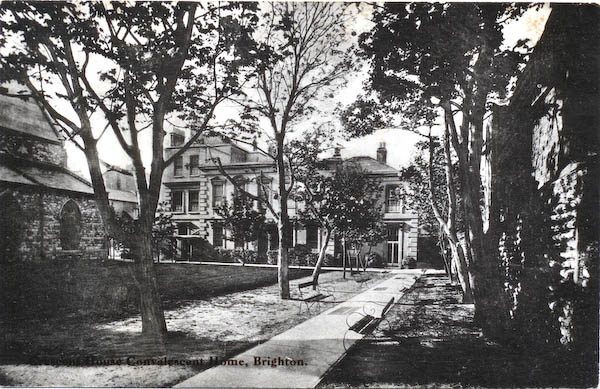Ebenezer Pannell

Crescent House Convalescent Home, Brighton. Card published by Pannell & Barnard, but printed by Mezzotint (posted 1908)
Brighton and Hove photographer. Pannell was born in 1860 in the Cliftonville area of Hove and was the son of a grocer. In 1882 he married Mary Ann Baker at Brighton. Seven years his senior, she had been born in London and worked as an assistant hairdresser in Kemp Town in east Brighton. By the following year Pannell had set up in business on his own as a portrait photographer at 21 Canning Street in Kemp Town. This was a quiet residential street and not the best of business locations. By 1888 he relocated to 28 Sudeley Place and to first 53 and then 49 St. Georges's Road in Kemp Town.
Pannell and his wife had four children: Ebenezer William Pannell (born in 1886), Ella Mary Pannell (born in 1888), Gordon George Pannell (born in 1892), and Eva Sarah Pannell (born on September 1, 1896). The 1891 census records that Pannell and his family lived 9 St George's Road in Kemp Town.
Pannell closed his Sudeley Place studio in about 1900 and at about the same time opened another at 16a Dyke Road in Brighton in partnership with Frederick James Holden. Holden had been born at Pulborough in 1873 and was the son of a railway signalman. He had worked on his own account as a photographer at Burgess Hill before joining forces with Pannell. In 1901 Pannell and Holden opened yet another studio, at 17 Compton Avenue in Brighton, which lasted until about 1903. The two partners moved the St George's Road studio first to Number 24 in 1904-5 and then to Number 113 in 1905. 1905 saw the opening of yet another studio, this time at 75 Church Road in Hove.
David Simkin has uncovered evidence that Pannell's sister, Frances (Fanny), a "photographic artist", helped Pannell and Holden manage some of the studios.The partnership between Pannell and Holden was dissolved in 1905, leaving Pannell in sole charge of the St George's Road and Church Road studios while Holden took complete control of the Dyke Road studio for a year or two before selling out to another photographer (Mrs Schofield) and returning to Burgess Hill.
By about 1906 Pannell formed a new partnership, this time with George Barnard (born at Hove in about 1877), who had previously been his assistant. The partnership lasted until March 1907, when it was dissolved. Barnard assumed sole control of the St George's Road Studio, where he confusingly continued trading under the name "Pannell & Barnard" until at least 1919. By 1921 Barnard bought Pannell out and started running the studio under his sole name.
Pannell specialised in portraiture and published relatively few postcard views of Brighton, though by 1908 he and Barnard were selling a series of collotype cards of the Crescent House Convalescent Home in Brighton, which had their name on the back. The earliest were printed for them by Mezzotint, but later examples seem to have been sourced elsewhere. Pannell and Barnard also published a captionless real photographic card of Harvest Festival decorations at an unidentified church, presumably in Brighton.
Pannell took a keen interest in the affairs of the Brighton and Hove Albion Football Club and for many years published postcards showing each season's team, identifying the individual players by name. He also published portrait cards of the top players as well as souvenir cards of important matches, most notably his card of the cup-tie match of January 1914 showing "Joe Leeming leading his men to victory" (reproduced by David Ticehurst in his book Brighton and Hove Albion, a portrait in old picture postcards (1994, S.B. Publications, Seaford). The team photos that Pannell produced date back to the 1905-6 season, if not earlier, and continue until the start of the First World War. For the 1910-11 season he joined up with Carter Bros. to produce a card of the team displaying the Southern League Challenge Shield and Southern Charity Cup that Albion had won during the previous season.
Pannell was assisted in the running of his studio at Church Road in Hove by his two daughters and by his son Ebenezer William Pannell. When the Royal Pavilion was converted into a military hospital soon after the start of the First World War, Pannell photographed wounded soldiers recuperating indoors and in the grounds. The resulting picture postcards blind-stamped "E. Pannell, 75 Church Rd., Hove" were amongst the last that he produced. Also dating from about 1915 is a real photographic of Sikh soldiers sitting in a charabanc in front of Queen Victoria's statue in Hove with Grand Avenue in the background. The card is entitled "From East to West for the Motherland" and like the Pavilion cards is blind stamped with Pannell's name and the Church Road address. He retired from business in about 1916 and died in Mid Sussex in 1934, having been a widower for 16 years.
Gordon Pannell emigrated to Australia as a young man, and took up farming. He fought at Gallipoli and on the Western Front in the First World War before returning to Australia.
Acknowledgement: Grateful thanks are due to David Simkin for supplying much useful information about the Pannell family and for helping to correct errors in an earlier version of this webpage. For a more detailed account you are recommended to visit his website at http://photohistory-sussex.co.uk.
To directory of publishersTo gallery
Design: Lucid Design
© www.sussexpostcards.info
